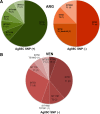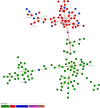Exploring the "Latin American Mediterranean" family and the RDRio lineage in Mycobacterium tuberculosis isolates from Paraguay, Argentina and Venezuela
- PMID: 31195979
- PMCID: PMC6567603
- DOI: 10.1186/s12866-019-1479-6
Exploring the "Latin American Mediterranean" family and the RDRio lineage in Mycobacterium tuberculosis isolates from Paraguay, Argentina and Venezuela
Abstract
Background: The Latin American & Mediterranean (LAM) spoligotype family is one of the most successful genotype of Mycobacterium tuberculosis worldwide and particularly prevalent in South-America. Within this family, a sublineage named Region of Difference Rio (RDRio) was reported initially in Brazil and is characterized by a genomic deletion of about 26.3 kb. This lineage seems to show a specific adaptation to the Euro-Latin American population. In this context, we sought to evaluate the LAM family and the presence of the RDRio genotype in samples from three Latin American countries including Paraguay, Venezuela and Argentina. To detect LAM strains reliably we applied a typing scheme using spoligotyping, 12 loci MIRU-VNTR, the Ag85C103 SNP and the regions of difference RDRio and RD174. IS6110-RFLP results were also used when available.
Results: Genotyping of 413 M. tuberculosis isolates from three Latin-American countries detected LAM (46%) and the ill-defined T clade (16%) as the most frequent families. The highest clustering rate was detected in the sample population from the city of Caracas in Venezuela. We observed considerable differences in the presence of the RDRio lineage, with high frequency in Caracas-Venezuela (55%) and low frequency in Buenos Aires-Argentina (11%) and Paraguay (10%). The molecular markers (RD174, Ag85C103, MIRU02-MIRU40 signature) of the RDRio lineage were essentially confirmed. For the LAM family, the most polymorphic loci were MIRU40, MIRU31, MIRU10, MIRU26, MIRU16 and the least polymorphic MIRU24, MIRU20, MIRU04, MIRU23.
Conclusions: Our results suggest a differential adaptation of LAM-sublineages in neighboring populations and that RDRio strains spread regionally with different rates of distribution. The Ag85C SNP and RDs (RD174, RDRio) tested in this study can in fact facilitate molecular epidemiological studies of LAM strains in endemic settings and low-income countries.
Keywords: Genotyping; LAM; Mycobacterium tuberculosis; Paraguay; South-America.
Conflict of interest statement
The authors declare that they have no competing interests.
Figures





Similar articles
-
Most LAM Mycobacterium tuberculosis strains in Venezuela, but not SIT605, belong to the RDRio subfamily.Infect Genet Evol. 2020 Oct;84:104380. doi: 10.1016/j.meegid.2020.104380. Epub 2020 May 26. Infect Genet Evol. 2020. PMID: 32470631
-
Application of sensitive and specific molecular methods to uncover global dissemination of the major RDRio Sublineage of the Latin American-Mediterranean Mycobacterium tuberculosis spoligotype family.J Clin Microbiol. 2008 Apr;46(4):1259-67. doi: 10.1128/JCM.02231-07. Epub 2008 Jan 30. J Clin Microbiol. 2008. PMID: 18234868 Free PMC article.
-
RDRioMycobacterium tuberculosis lineage in the Brazil/Paraguay/Argentina triple border.Tuberculosis (Edinb). 2018 May;110:68-78. doi: 10.1016/j.tube.2018.03.008. Epub 2018 Mar 31. Tuberculosis (Edinb). 2018. PMID: 29779776
-
Genotyping methods and their contributions to the study of tuberculosis dynamic in Latin America.J Infect Dev Ctries. 2023 Nov 12;17(10):1373-1386. doi: 10.3855/jidc.17840. J Infect Dev Ctries. 2023. PMID: 37956372 Review.
-
[New era in molecular epidemiology of tuberculosis in Japan].Kekkaku. 2006 Nov;81(11):693-707. Kekkaku. 2006. PMID: 17154049 Review. Japanese.
Cited by
-
Mycobacterium tuberculosis lineage 4 associated with cavitations and treatment failure.BMC Infect Dis. 2023 Mar 14;23(1):154. doi: 10.1186/s12879-023-08055-9. BMC Infect Dis. 2023. PMID: 36918814 Free PMC article.
-
Global epidemiology of Mycobacterium tuberculosis lineage 4 insights from Ecuadorian genomic data.Sci Rep. 2025 Jan 30;15(1):3823. doi: 10.1038/s41598-025-86079-8. Sci Rep. 2025. PMID: 39885182 Free PMC article.
-
Whole genome analysis of extensively drug resistant Mycobacterium tuberculosis strains in Peru.Sci Rep. 2021 May 4;11(1):9493. doi: 10.1038/s41598-021-88603-y. Sci Rep. 2021. PMID: 33947918 Free PMC article.
-
Prevalence, drug resistance, and genotypic diversity of the RDRio subfamily of Mycobacterium tuberculosis in Ecuador: a retrospective analysis for years 2012-2016.Front Public Health. 2024 Apr 4;12:1337357. doi: 10.3389/fpubh.2024.1337357. eCollection 2024. Front Public Health. 2024. PMID: 38689770 Free PMC article.
-
Decoding Ecuadorian Mycobacterium tuberculosis Isolates: Unveiling Lineage-Associated Signatures in Beta-Lactamase Resistance via Pangenome Analysis.Biomedicines. 2025 Jan 28;13(2):313. doi: 10.3390/biomedicines13020313. Biomedicines. 2025. PMID: 40002726 Free PMC article.
References
-
- WHO . Global tuberculosis report. 2018.
Publication types
MeSH terms
Substances
LinkOut - more resources
Full Text Sources
Medical
Miscellaneous

